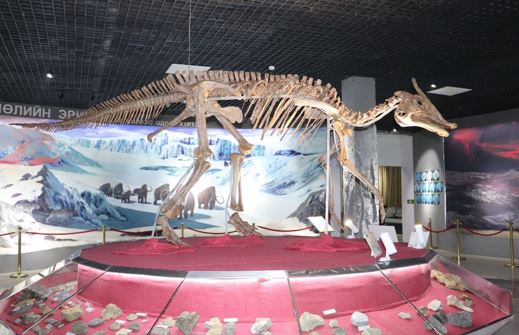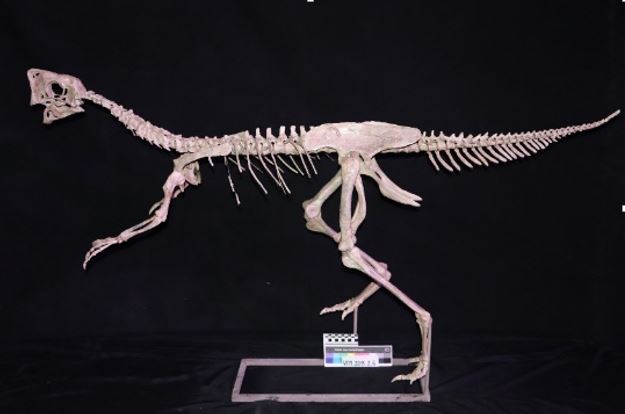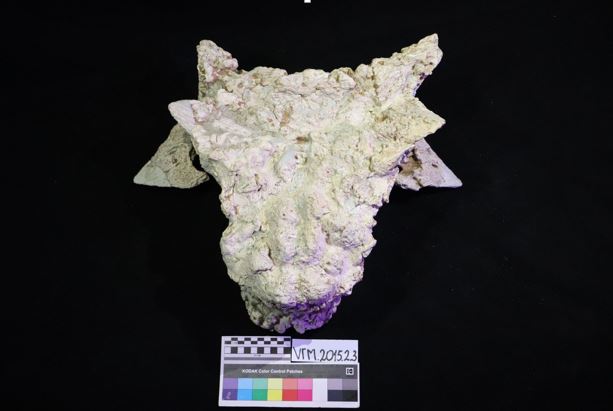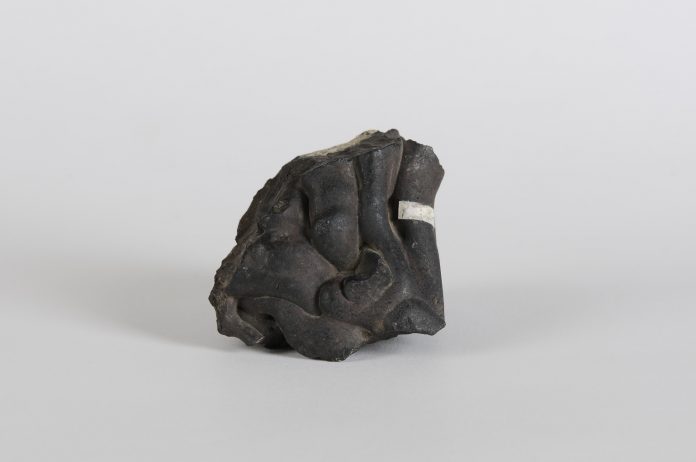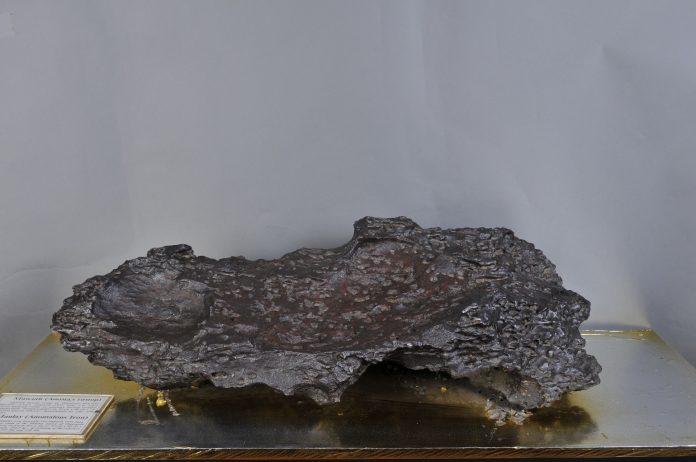
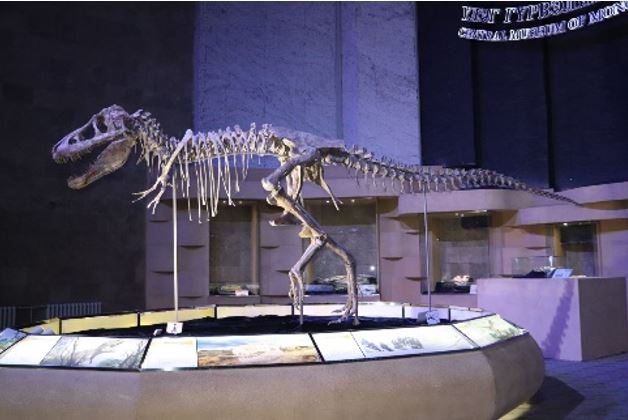
Terrible dinosaur – Tarbosaurus bataarScientific name: Tarbosaurus bataarName meaning: Lat. tarbo = terrible, saurus = dinosaur, bataar = hero Body size: Length 10-12 meters, Height 4 meters, Weight 2-3 tons Food: Carnivorous Place of discovery: Mongolia, Mungogov Province, Nemagt layer Geological time: Late Cretaceous (71 -65 million years ago) Taxonomy: Theropoda Marsh, 1881 Tyrannosauridae Osborn, 1905 Tarbosaurus Maleev, 1955 Tarbosaurus bataar Maleev, 1955 Tarbosaurus bataar is considered the largest carnivorous giant dinosaur that lived in the Cretaceous period. It moved quickly with its hind legs, and its long tail had large muscles in that area, so it held the tail almost horizontally and acted as a balance during movement. The length of the body of Tarbosaurus is 7.5m, height is 2.5m, and 75% of it is a fossil and the rest is a replica.
Duck-billed dinosaur – SaurolophScientific name: Saurolophus sp. Name meaning: Lat. sauros = lizard, lophus = pointed top Body size: Length 7-12 meters, Weight 1.9-2.1 tons Food: herbivore Old place: Mongolia, Mungogov Province, Nemegt layer Geological time: Late Cretaceous (71-65 million years ago) Taxonomy : Ornithopoda Marsh, 1881 Hadrosauridae Cope, 1869 Hadrosaurinae Lambe, 1918 Saurolophus Rozhdestvensky, 1952 The largest organism in this family belongs to herbivorous dinosaurs. In normal conditions, it walks on its hind legs, but in alarming situations, it is assumed that it ran on all fours to escape from danger. There are many fossils of Saurolophus dinosaurs, some of which have their skin imprints preserved in the archaeological site called Luugi Bulsh in the Nemet Valley. Skin impressions are found that testify to the fact that the tail of the Zavrolof dinosaur was cross-striated.
Egg-stealing dinosaur – OviraptorScientific name: Oviraptorosauria. Meaning of the name: Lat. ovi = egg, raptor = predator sauria = lizard Body size: 1.5-2.5 meters in length Diet: omnivore Found place: Mongolia, Mungogov province, Jodohtyn davhargadas Geological time: Late Cretaceous (84-80 million years ago) Classification: Theropoda Marsh, 1881 Oviraptorosauria Barsbold, 1976 In 1923, researchers from the Central Asian expedition led by researcher Roy Chapman Andrews of the United States Museum of Natural History first discovered the skeleton of an oviraptor dinosaur in a position on an egg. The researchers attributed the fossilized eggs to the eggs of the horned dinosaur, mainly because fossils of all stages of growth of the horned dinosaur were found, starting with the chain bones of the baby horned dinosaurs. 70 years later, a Citipati species was found laying eggs inside the Oviraptor nest, and the fossilized egg was confirmed to be an Oviraptor egg. In this way, the "egg thief" immediately turned into "Big Mama".
Armored dinosaur – Ankylosaurus Scientific name: Ankylosauridae sp Meaning of the name: Lat. ankylo = armor, sauros = lizard Body size: Length 2.5-8 meters, Weight 5-7 tons Food: herbivore Old place: Mongolia, Mungogov province, Jodokht layer Geological time: Late Cretaceous (71-65 million years ago) Taxonomy: Thyreophora Nopsca , 1915 Ankylosauridae Brown, 1915 Ankylosaurus head and body were covered with armor, although it was clumsy in terms of movement, it was a four-legged dinosaur with sharp eyesight and a well-developed sense of smell. With the help of the large bone at the tip of the tail, other carnivorous dinosaurs defended themselves by hitting other animals with an impact force of approximately 1390 kg. Namnandorj was first found in the ruins of a historical monument called Khubilai Tsetsen Khan's Military City, located on the west side of the Teel River in Nary Teel Sum area of Uvorkhangai Province. When it was first found, the large piece, black in color and like iron ore, was 9-10 cm long, 4 cm high, and weighed 540 g. The smaller piece was 5 cm long, 3 cm wide, 2 cm high, and weighed 80 g. A total of 620 g was found. According to the results of the chemical laboratory under the Geological Exploration Administration, it was found to be an iron meteorite, which also had magnetic properties. It is named after Khan-khokshin mountain in the Teel River area of Overkhangai Province. Dimensions: length: 7.6 cm, width: 6.6 cm, height: 5.6 cm, weight: 506.7 g.
Khan old meteorite: The meteorite was discovered in September 1957 by O. Namnandorj was first found in the ruins of a historical monument called Khubilai Tsetsen Khan's Military City, located on the west side of the Teel River in Nary Teel Sum area of Uvorkhangai Province. When it was first found, the large piece, black in color and like iron ore, was 9-10 cm long, 4 cm high, and weighed 540 g. The smaller piece was 5 cm long, 3 cm wide, 2 cm high, and weighed 80 g. A total of 620 g was found. According to the results of the chemical laboratory under the Geological Exploration Administration, it was found to be an iron meteorite, which also had magnetic properties. It is named after Khan-khokshin mountain in the Teel River area of Overkhangai Province. Dimensions: length: 7.6 cm, width: 6.6 cm, height: 5.6 cm, weight: 506.7 g.
Manlay Meteorite: This meteorite was discovered by O. In 1952 and 1953, a person named Namnandorj reported the location of the Three Dependent Mologo-Dersen water in the Manlai sum area of Umungov province, about 90 km south of the sum center.
